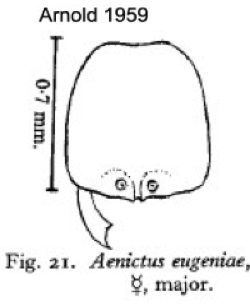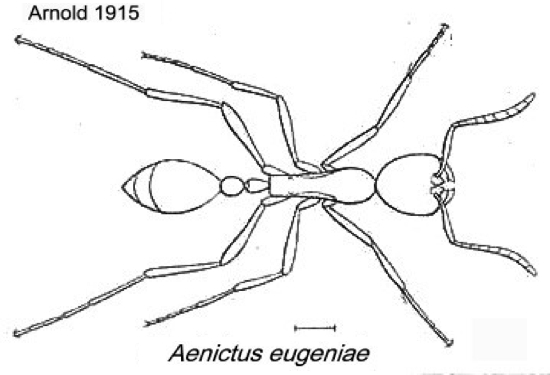Aenictus eugenii Emery
  Type location South
Africa (Aenictus Eugenii,
n. sp., Emery, 1895h: 17, worker, illustrated) from Bothaville Type location South
Africa (Aenictus Eugenii,
n. sp., Emery, 1895h: 17, worker, illustrated) from Bothaville
junior synonym kenyensis (Aenictus
eugeniae Em. v. kenyensis
n. var., Santschi, 1933b: 100, worker;
synonymy by Gotwald & Cunningham-van Someren, 1976: 183, also
queen) from Kenya, Kiambou, 27.ii.1929, R H Le Pelley - see below
subspecies
caroli (Aenictus
eugenii Em. subsp. caroli
n. subsp., Forel, 1910c:
248, worker) from Eritrea, Nefassit - see http://www.antweb.org/specimenImages.do?code=casent0907026
henrii (Aenictus
eugenii Em. v. henrii
n. var., Santschi,
1924b: 204, worker) from Zaïre, Kidada nr Kitobola, H Schouteden - see http://www.antweb.org/specimenImages.do?code=casent0911423
worker & queen described
(see Bolton, 1995)  . .
|
  Amended translation taken from Arnold (1915: 139), plus
his notes - Amended translation taken from Arnold (1915: 139), plus
his notes -
(Plate IV., fig. 38, right) Emery, Ann. Soc. Ent. France, vol.
63, p. 48, worker , 1895.
Worker - TL 3.7-4 mm. Larger and. much darker than rotundatus,
and. varying less in size than that species. The colour is a bright
castaneous red, lighter on the abdomen. The legs are yellowish red, the
sides of the thorax below, and the mandibles, brownish red.
This species closely resembles rotundatus,
differing from it only in the following characters. The pilosity is
less abundant, but more regularly distributed and longer. The head is
distinctly wider in front than behind. The masticatory margin of the
mandible is smooth and edentate, or, in some specimens with traces of
three minute teeth behind the apical tooth, which is blunter than in rotundatus.
The antennae are rather longer, the scape almost reaching back to the
occipital margin, and all the joints of the funiculus are distinctly
longer than wide. The thorax is rather narrower, and less compressed
between the mesonotum and propodeum. The latter is strongly
reticulate-punctate, as are also the sides of the mesonotum, the whole
of the 1st joint of the petiole, and the sides of the 2nd. The
puncturation is decidedly larger and more distinct than in rotundatus.
The posterior corners of the pronotum also show a slight puncturation.
The dorsal surface of the 2nd joint of the petiole is nearly smooth and
rather shining. The limits of the dorsum and the declivity of the
propodeum are clearly defined, as the brow forms a sharp overhanging
edge, so that the declivity also appears somewhat concave. The 1st node
of the petiole is a little narrower, more parallel-sided and less
convex above than in rotundatus. Legs longer and more slender,
the 1st tarsal joint of the hind legs as long as the tibiae.
Bothaville, Orange Free State. (Brauns.) Makapan.
(Simon.) Bulawayo.
This
species was taken on one occasion near Bulawayo in large numbers,
marching in single file and carrying larvae from under one large stone
to another. Amongst these workers there was found a monstrosity. This
specimen has but one joint to the petiole, which is fused on the whole
of its anterior surface to the propodeum, which consequently shows no
declivity, and is moreover very lop-sided. (S.A.M., R.M., G.A. colls.).
|